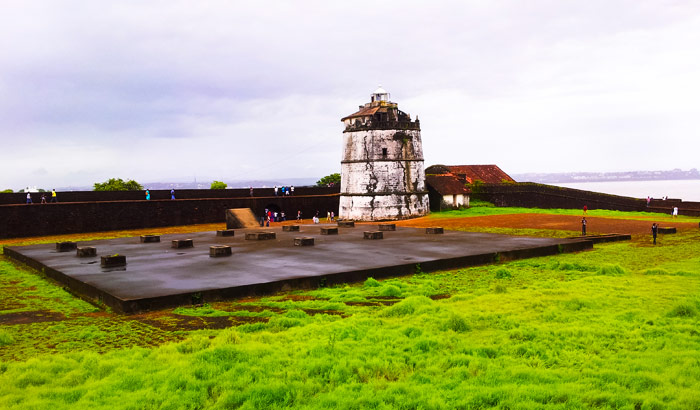The history of Goa has been a long and illustrious one. For the tiniest state in India, it was much sought after by different kingdoms in the country given its strategic location on the west coast. The added factor of possessing one of the few natural harbors in the country made it all the more desirable to invading forces. And it was at the mouth of the Mandovi river, high up on a hill, that the Portuguese built the mighty Fort Aguada to ward off attacks on Old Goa.
Fort Aguada is a vital part of Goa’s culture and history
During the Portuguese rule in Goa, one of the first things they did was to build forts at different strategic locations across the state. Today, almost all of these lie in ruins. The government is trying to restore them but it’s a long road to recovery for these mighty structures. However, forts like Reis Magos and Fort Aguada seem to be in a better state than most. In fact, the Reis Magos fort underwent renovations a few years ago and has regained some semblance of how it must have looked back in the Portuguese days.
The magnificent architectural marvel that is Fort Aguada is still standing strong minus its artillery of course. This 17th-century fort was built sometime around 1609-12, to control the entry into the river Mandovi and to protect Old Goa from potential enemy attacks. To this day, it is well-preserved and a frequently visited spot by locals as well as tourists. At one point of time, the fort was protected by 200 cannons as well as a dry moat which still has to be crossed to gain entry to this massive structure. The walls are 5 meters high and 1.3 meters wide. Given those kinds of dimensions and that much artillery, it’s no surprise that this was the only fort that remained unconquered by any outside forces during Portugal’s 450-years rule over Goa.
High atop a hill stands a mighty fortress
Fort Aguada gets its name from the freshwater springs that wound its way within the fort’s recesses. It was from these springs that fresh drinking water was provided to the ships that stopped at the fort. The word ‘Aguada’ is derived from the Portuguese word for water which is água.
The fort is the largest one in Goa and is divided into two parts. The upper part acted as fort and watering station, while the lower part served as a safe berth for Portuguese ships. The upper half contains the dry moat and an underground water storage chamber which could hold approximately 10 million liters of fresh water. There was also a gunpowder room, an unusual lighthouse and bastions, and even a secret escape passage to use during the time of war and emergency. The water storage chamber was believed to be the greatest at the time of being built.
The Aguada lighthouse
The old lighthouse within the fort was built in 1864 and still stands 13 meters high and served to warn ships in the distance of the cruel rocks located below. It used an oil lamp whose flame could be seen for miles out at sea. Today, this lighthouse is no longer in use. There is a more modern lighthouse located just beyond the walls of the fort which serves the same purpose.
There was also an enormous bell that was housed within the lighthouse but was eventually moved to the Church of Immaculate Conception in Panjim. The fort also housed a prison at one point at the bottom which was operational until a few years ago.
Today, despite the partial ruin of Fort Aguada, it’s not difficult to see how majestic it must have been during Portuguese rule, filled with soldiers doing their duty and protecting the entrance of the Mandovi river against interlopers. It was the Portuguese empire’s most important fort out of all the forts built and was never conquered during their entire reign.
Information credit
http://www.goatourism.gov.in/destinations/forts/150-aguada-fort
ItsGoa/OCT/KDGP


